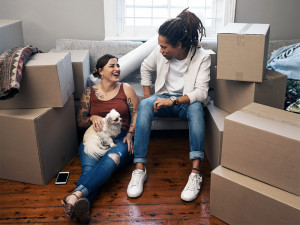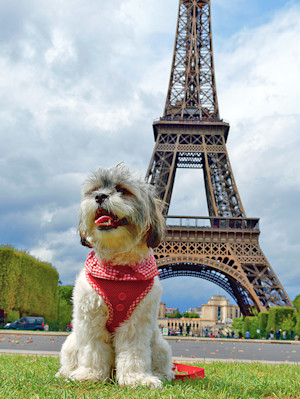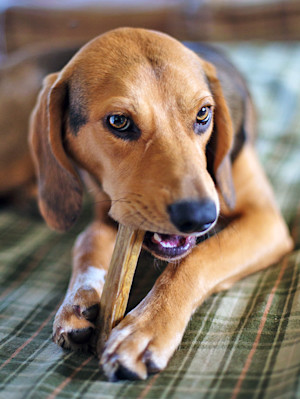What to Expect When Taking Your Dog Abroad By Plane
Jet-setting with your dog? Here’s everything you need to know.
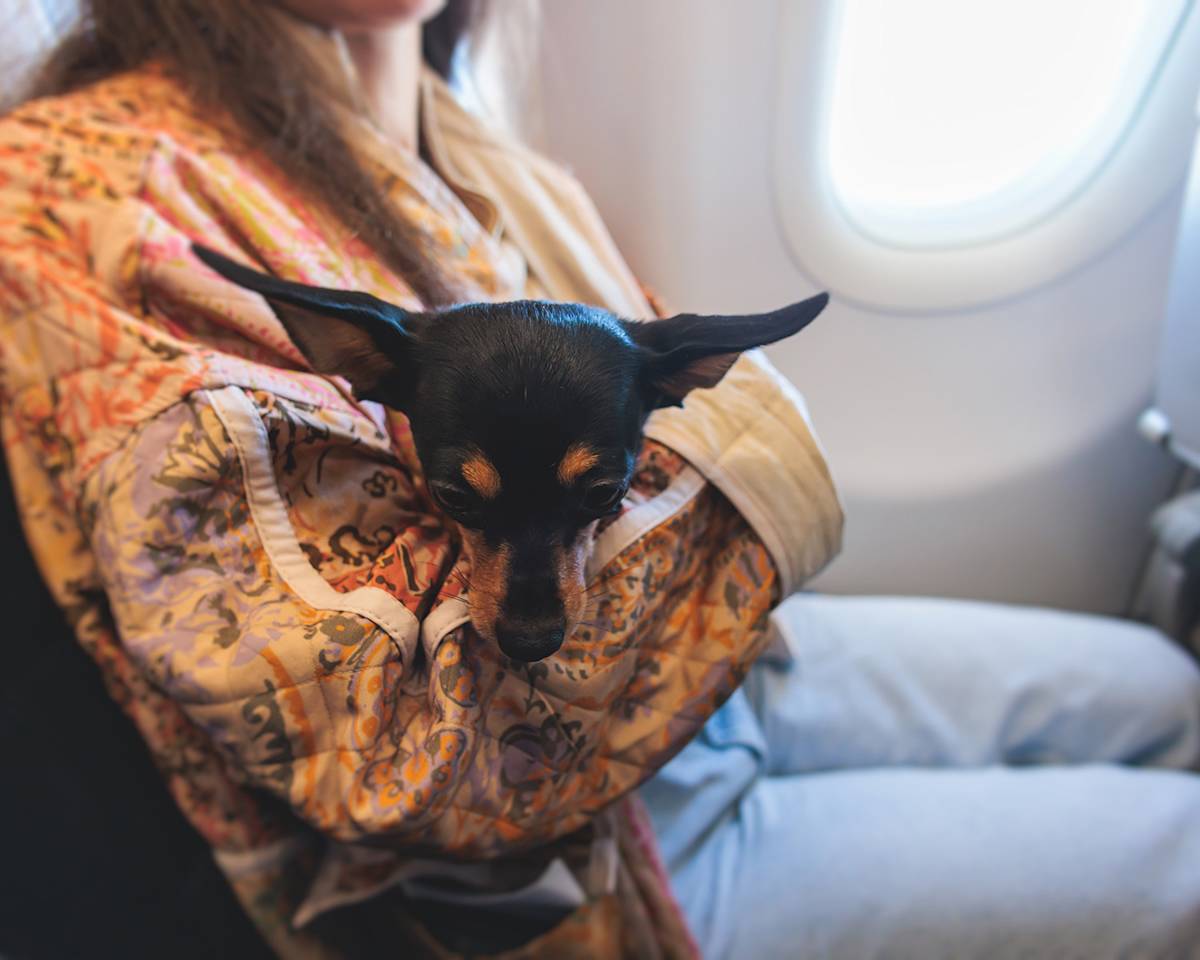
Share Article
Want a European holiday without having to leave your dog at home? Planning a new life overseas and figuring out the best way to transport your precious pooch? Air travel has become the norm for our generation (are you old enough to remember when low-cost airlines entered the chat?) and these days, you can even bring your dog along for the ride. It may not be a suitable option for all dogs and it’s certainly not a breeze, but the means of getting your dog airborne and avoiding lengthy or stressful journeys by land or sea do exist.
Whether you’re taking your dog to France or further afield, we’ve got the skinny on what’s involved when jetting off with your best friend. You better tell them to start packing their suitcase with their fave treats and toys…
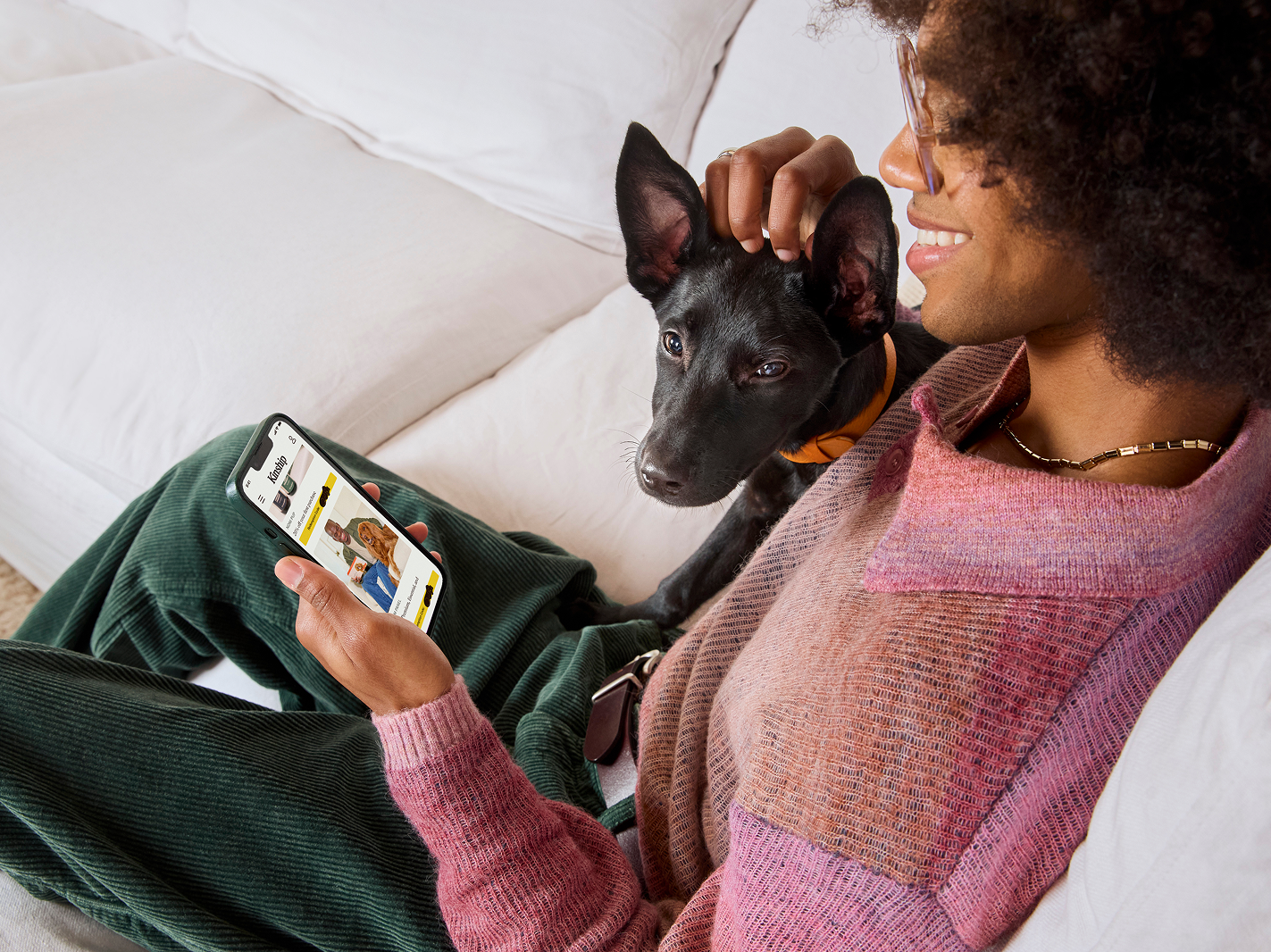
Get (totally free) deals for food, treats, accessories, tech and way more pet parenting must-haves.
Can you take your dog on an airplane?
Thankfully, loads of airlines allow dogs on flights to and from the UK, whether that’s in the cabin, as excess baggage, or as cargo. However, if you’re planning on bringing your dog back to Great Britain, be aware that it’s a bit trickier (and potentially a lot more expensive) on the return journey due to UK customs laws that require dogs (excluding assistance dogs) to fly as cargo on commercial planes. The only way around this is to book a private charter. Other options are to travel back to the UK via Calais on LeShuttle (fyi dogs aren’t allowed on the Eurostar train) or on a ferry via Calais or Amsterdam.
Airline pet policies
Each airline has its own rules and regulations, which should be stated clearly on their respective websites. If in doubt, contact the airline’s customer service as there’s zero room for error when travelling with a pet.
Breed and size restrictions
If you’re dreaming of sharing snacks in the cabin with your furry bestie, think again – unless they’re super small (and well-behaved). Most commercial airlines won’t allow dogs in the cabin, and those that do require dogs to weigh less than 8kg (including the carrier) and be small enough to fit comfortably under the seat in front of you. FYI, Aegean Airlinesopens in new tab, Air Franceopens in new tab, KLMopens in new tab, LOTopens in new tab and Lufthansaopens in new tab do allow dogs in the cabin.
For dogs in the hold, there’s usually an upper weight restriction, which varies by airline.
Assistance dogs don’t count as pets and by law airlines must allow service dogs in the cabin free of chargeopens in new tab. However, if your service dog is on the larger side you may have to pay for an extra seat.
Most airlines won’t fly brachycephalic breeds such as Pugs in the hold, as they often experience breathing difficulties in stressful environments, which could be disastrous when flying. Most airlines also have a banned breeds list (sorry, Pit Bulls).
Fees and costs of dog airplane travel
The cost of your dog’s flight ticket will vary greatly depending on the airline, the route, and whether they’re flying in the cabin, as excess baggage, or cargo. Some airlines will only take dogs as cargo, which is considerably more expensive than excess baggage. You could be looking at shelling out thousands of pounds for this, depending on the destination. Yikes.
However, fees can be as low as €65 (~£55) for a small dog in the cabin on an international flight with Aegean Airlinesopens in new tab. Some airlines, such as Qatar Airwaysopens in new tab, charge a set baggage fee for dogs in the hold, starting at $200 (~£146) for a dog weighing less than 32kg.
How to book a flight with your dog
It’s best to book as far in advance as possible as only a limited number of animals are allowed on each flight. Some airlines allow you to add a pet during the initial booking process, while others require you to book your own ticket and then add your dog afterwards.
If this all sounds like a bit of a headache and you have some extra cash to spend, you could consider using a pet export agent. This may cost more than doing it yourself, but it could also make the process much easier.
List of commercial airlines that allow dogs
The following airlines all carry animals (in the hold and/or cabin), servicing a selection of airports across the UK. This list is correct at time of publishing, and is taken from the UK government websiteopens in new tab (so blame them if it’s wrong, OK?).
Aeromexico
Aegean Airlines
Aer Lingus
Air Astana JSC
Air Baltic Corporation
Air Canada
Air Europa
Air France KLM Martinair Cargo
Air India
Air Mauritius
Air New Zealand
Air Transat
All Nippon Airways
American Airlines
Atlantic Airways
Austrian Airlines
Avianco
Azerbaijan Airlines
Blue Air Aviation SA
British Airways
Brussels Airlines
Cathay Pacific
China Airlines Ltd
China Southern
Czech Airlines
Delta Air Lines
Egyptair
Emirates
Emirates SkyCargo
Ethiopian Airlines
Etihad Airways
Etihad Cargo
EVA Airways
Finnair
Gulf Air
Iberia
Iberia Express
Icelandair
Japan Airlines
JSC Rossiya Airlines
Kenya Airways
KLM Royal Dutch Airlines Cargo
Korean Air
Kuwait Airways
LOT Polish Airlines
Lufthansa
Malaysia Airlines
Middle East Airlines
Norse Atlantic UK Ltd
Oman Air
Philippine Airlines
Qantas
Qatar Airways
Royal Brunei Airlines
Royal Jordanian Airlines
Rwandair
Scandinavian Airlines System Cargo
Singapore Airlines
South African Airways
SriLankan Airlines
Swiss WorldCargo
Tarom Romanian Air Transport
Thai Airways
Travel Service - SmartWings
TUI Airways
Turkish Airlines
Uganda Airlines
United
Uzbekistan Airways
Vietnam Airlines
West Atlantic Aviation UK
WestJet
How to prepare your dog for air travel in the EU
1. Microchip your pet
By law, all dogs over eight weeks old need to be microchipped and registeredopens in new tab on an approved database, so you’ve probably ticked this box already. If you haven’t, get it done at your local vet and make sure you do so before getting your dog’s rabies vaccine (see below).
2. Get your pet vaccinated against rabies
All dogs flying out of the UK must be fully vaccinated against rabies. Be aware that your dog must wait at least 21 days after completing the initial vaccination protocol before flying. If they’re already vaccinated, check if a booster is required.
3. Get a pet travel document
In the 10 days before you enter the EU, you’ll need to take your dog to the vet to get an Animal Health Certificate (AHC). This will show proof of their vaccination, microchipping and dewormer (if applicable) status. It can’t just be any old vet though — make sure you visit an ‘official veterinarian’ (OV), ie, a vet who’s been authorised by the government to carry out such services. This certificate can also be used for re-entry into the UK, so long as you come back within four months.
You can skip this step if you have a valid pet passportopens in new tab that was issued in Northern Ireland or the EU. EU pet passports issued in the UK became invalid to enter the EU (thanks Brexit…) in 2021. However, the UK government and the EU have recently made a U-turn to reinstate the ‘old’ EU pet passport system in the UK in the near future (watch this space).
4. Get a tapeworm treatment for your dog
Travelling to Ireland, Northern Ireland, Malta, Finland or Norway? Your dog will need to take an approved Echinococcus tapeworm treatmentopens in new tab between 24 and 120 hours of arrival. This must be recorded on their pet passport or Animal Health Certificate. FYI: you won’t need to do this if you’re travelling to Northern Ireland and have a Northern Ireland pet travel document (PTD)opens in new tab.
5. Choose the right type of transport
Most airlines require dogs to travel in secure, well-ventilated crates approved by the International Air Transport Association (IATA) when flying in the hold. These must be roomy enough for your dog to lie in a natural position, as well as allow them to stand up and turn around with ease. However, they shouldn’t be too big, as you want your dog to feel safe and cosy, and protected during turbulence. Grab a tape measure and check out the IATA-approved crate dimension guideopens in new tab to find the perfect fit for your pooch.
If your dog’s travelling in the cabin, you’ll need a secure, breathable pet carrieropens in new tab that fits under the seat in front of you.
Every airline will have its own individual requirements, so check carefully before spending big bucks on a carrier – those things ain’t cheap, honey.
6. Figure out how to keep your dog comfortable during the flight
Flying is stressful enough for humans, let alone dogs who have no idea what’s going on. Your dog will feel more relaxed if they view their travel carrier as a safe space, so crate trainingopens in new tab in advance is key. “A dog’s number one sense is scent, so make sure they’re travelling with items that have their own scent on, like a blanket from home” says dog behaviourist Jeanette Muldoonopens in new tab. “This will help them feel more safe.”
Use absorbent vet bedding in case they need to do a wee, and don’t include any toys that could become choking hazards. Make sure they’ve had a long walk before setting off for the airport and give them a toilet break right before check-in.
The IATA strongly recommends not sedating your dogopens in new tab due to the potential for adverse effects at altitude. Speak to your vet about alternative stress remedies for your dog.
What to expect when you arrive at the airport
If your dog’s flying in the hold, you’ll be instructed to check them in at the airport’s animal centre, for example, Heathrow Animal Reception Centre or Pets on Jets at Manchester Airport. You’ll be advised how early to arrive. Once documentation has been approved, you’ll then have to go to the main terminal to check yourself in, so leave plenty of time, especially if you want a cheeky airport pint (or flat white).
What to do when you arrive at your destination
Be prepared for your dog to be sleepy, anxious or disoriented after flying. Let them stretch their legs, have a bathroom break, and give them time to decompress and settle into their new location. Make sure they have familiar items (hello favourite toy and blankie) and be alert for signs of stress. Always keep them on a lead in new surroundings, and consider investing in a GPS tracker.
Tips for flying with your dog
Get them used to airports
Where possible, take a few trips to the airport before the day of travel, to familiarise your dog with the smells and sounds. “Arm yourself with treats or a favourite toy and start far from the airport, gradually getting closer and closer,” advises Muldoon. “You can even keep them in the car to do this, feeding them treats while they get used to the noises.”Keep a close eye on your dog during this process to see how anxious they’re feeling.
“Understanding stress signals in dogs is really important when you’re working through desensitisation,” Muldoon explains. “If they’re showing subtle signs like tongue flicks, yawns, or cheek puffing, help them out by reassuring them with a hand to the chest. More obvious signs of fear like ears going back, barking, grabbing the lead, or tucking their tail under means it’s time to get them out of the situation and try again another day.”
Play airplane hold noises at home
“You can play cargo hold white noiseopens in new tab at home but always make sure you pair it with something of high value, like play,” says Muldoon. “Have it on in the background while you play with them, or play it and then give them a treat, before turning the noise off.”
Plan your journey carefully
If your flight involves a layover and your dog’s in the hold, research what will happen to them during the stop. Some airports have dedicated live animal facilities, although they may be restricted to certain airlines. For example, Qatar Airways, Etihad and Emirates all have animal transport centres at their UAE hubs, with kennels, vets, trained handlers and climate-controlled vehicles to chauffeur your pet to/from the plane. Don’t forget to check if the airline has a minimum/maximum layover duration as this may impact your journey.
Lucky enough to have your dog in the cabin? Select airports – such as Doha’s Hamad International, Rome Fiumicino, Istanbul, Paris-Charles de Gaulle and Helsinki – have special pet relief areas in terminals.
Go easy on the goodbye
We get it, parting with your beloved pet and leaving them with strangers is incredibly distressing, especially when you know you won’t see them for a while. However, for the sake of their wellbeing, try to keep it together when saying au revoir at check-in.
“Be careful saying bye because they pick up on our emotions when we get upset,” warns Muldoon. “This will then influence how they feel. If we get them in an excited state, they may also find it hard to settle.”
Our advice? Be chill, be brief. (Easier said than done, we know…)
Bottom line: taking dogs abroad by plane
Many airlines allow you to take your dog overseas on a plane, although most require dogs to travel in the hold. Flying with a dog can be stressful for all concerned, so consider if the journey is absolutely necessary. You can take some of the worry away by using the services of a pet export agent.
FAQ (People also ask)
Can you take dogs abroad by plane?
You can indeed. Many airlines allow dogs to travel overseas, either in the cabin or in the hold.
How much does it cost to fly a dog internationally?
Flying a dog overseas from the UK is free for assistance dogs. Regular pet dogs might cost as little £55 to fly in the cabin, though it can rise well into the thousands to transport a large dog as cargo on a long haul flight.
Can I fly with my dog internationally?
You can fly a dog internationally so long as you have the correct documentation as required by the airline and destination country. However, not all airlines allow dogs, so do your homework and check out our list above.
How much does it cost to fly a dog to Cyprus?
If you use a pet travel agent like Fetchapetopens in new tab, it can cost from £1,400 to £6,000 to fly a dog to Cyprus from the UK. You can save money by booking yourself — on KLMopens in new tab it costs from €70 (~£60) to €500 (£427), depending on departure airport and destination.
References
“Travelling With an Assistance Dog | UK Civil Aviation Authority.opens in new tab” 26 June 2025.
“Pet Travel: Airlines and Airports You Can Use.opens in new tab” GOV.UK, 26 June 2025.
“Get Your Dog or Cat Microchipped.opens in new tab” GOV.UK, 12 May 2016.
Government Digital Service. “Taking Your Pet Dog, Cat or Ferret Abroad.opens in new tab” GOV.UK, 21 Dec. 2020.
“Pet Travel Cyprus & TRNC | Pet Transport to Cyprus From UK (Dog & Cat Export) - Fetchapetopens in new tab.” Fetchapet, 26 June 2024.
“Flying With a Dog or Cat in the Cabin or Hold - KLM Cyprus.opens in new tab” Flying With a Dog or Cat in the Cabin or Hold - KLM Cyprus.
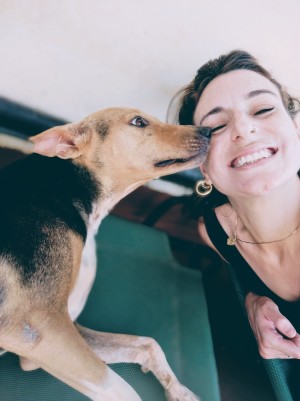
Lisa Bowman
Lisa is a writer whose work has been featured in the likes of Stylist, Metro and The Guardian. She spends her days at a computer so she can bankroll her two rescue dogs, who may or may not be The Cutest Dogs in the World.
Related articles
![a woman and a man sit in an empty home surrounded by boxes with a dog]()
Moving Abroad With Your Dog? Here’s Everything You Need To Know
Moving house is stressful at the best of times, but what happens if you want to move abroad with your dog? We consulted some experts to find out
![a little white dog in a red harness poses in front of the Eiffel tower]()
Excusez-Moi, Does My Dog Need a Passport to Go to France?
Planning on summering in France avec ton chien? Read this first
![Picture of close up scared chihuahua in their bed]()
75% of People Can’t Spot When Their Dog Is Worried – Are You One of Them?
Rolling on their back doesn’t automatically mean they want belly rubs...
![a close up picture of a beagle chewing a chew]()
Making Short Absences Easy: How To Leave Your Dog Home Alone
Scientists from the Waltham Petcare Institute explain how one simple buy could help your nervous pup feel more comfortable by themselves
![Dog running on the beach]()
Can I Take My Anxious Dog On Holiday?
Think a holiday with your nervous pup is off-limits? You just need to make a few adjustments. Here’s how to have a dreamy trip that you and your anxious dog can enjoy
